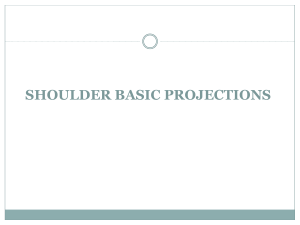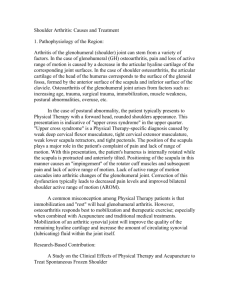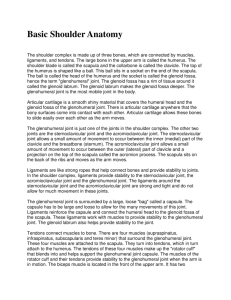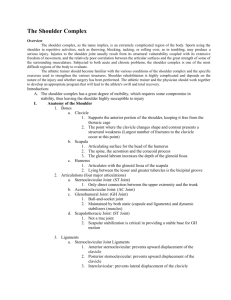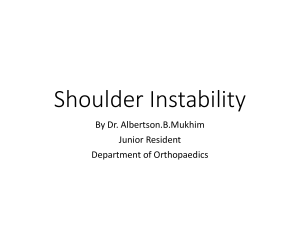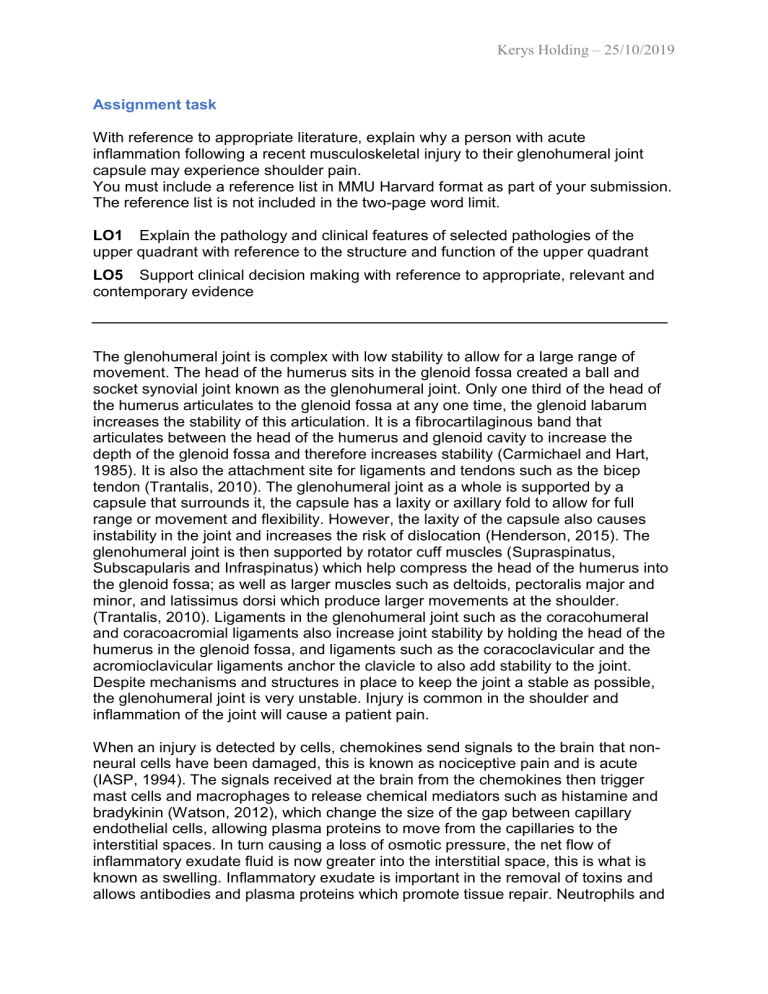
Kerys Holding – 25/10/2019 Assignment task With reference to appropriate literature, explain why a person with acute inflammation following a recent musculoskeletal injury to their glenohumeral joint capsule may experience shoulder pain. You must include a reference list in MMU Harvard format as part of your submission. The reference list is not included in the two-page word limit. LO1 Explain the pathology and clinical features of selected pathologies of the upper quadrant with reference to the structure and function of the upper quadrant LO5 Support clinical decision making with reference to appropriate, relevant and contemporary evidence The glenohumeral joint is complex with low stability to allow for a large range of movement. The head of the humerus sits in the glenoid fossa created a ball and socket synovial joint known as the glenohumeral joint. Only one third of the head of the humerus articulates to the glenoid fossa at any one time, the glenoid labarum increases the stability of this articulation. It is a fibrocartilaginous band that articulates between the head of the humerus and glenoid cavity to increase the depth of the glenoid fossa and therefore increases stability (Carmichael and Hart, 1985). It is also the attachment site for ligaments and tendons such as the bicep tendon (Trantalis, 2010). The glenohumeral joint as a whole is supported by a capsule that surrounds it, the capsule has a laxity or axillary fold to allow for full range or movement and flexibility. However, the laxity of the capsule also causes instability in the joint and increases the risk of dislocation (Henderson, 2015). The glenohumeral joint is then supported by rotator cuff muscles (Supraspinatus, Subscapularis and Infraspinatus) which help compress the head of the humerus into the glenoid fossa; as well as larger muscles such as deltoids, pectoralis major and minor, and latissimus dorsi which produce larger movements at the shoulder. (Trantalis, 2010). Ligaments in the glenohumeral joint such as the coracohumeral and coracoacromial ligaments also increase joint stability by holding the head of the humerus in the glenoid fossa, and ligaments such as the coracoclavicular and the acromioclavicular ligaments anchor the clavicle to also add stability to the joint. Despite mechanisms and structures in place to keep the joint a stable as possible, the glenohumeral joint is very unstable. Injury is common in the shoulder and inflammation of the joint will cause a patient pain. When an injury is detected by cells, chemokines send signals to the brain that nonneural cells have been damaged, this is known as nociceptive pain and is acute (IASP, 1994). The signals received at the brain from the chemokines then trigger mast cells and macrophages to release chemical mediators such as histamine and bradykinin (Watson, 2012), which change the size of the gap between capillary endothelial cells, allowing plasma proteins to move from the capillaries to the interstitial spaces. In turn causing a loss of osmotic pressure, the net flow of inflammatory exudate fluid is now greater into the interstitial space, this is what is known as swelling. Inflammatory exudate is important in the removal of toxins and allows antibodies and plasma proteins which promote tissue repair. Neutrophils and Kerys Holding – 25/10/2019 macrophages also dispose of debris and bacteria in the area via phagocytosis (Suvas, 2017) This will cause pain in the patient as when the chemical mediator are released they stimulate nerve endings, when the area is acutely inflamed the body will perceived these signals as pain until the inflammation reduces (Choi, 2017). In conclusion the best treatment for this patient will be acute inflammation treatment including ice, compression and elevation. The body’s inflammatory response is a vital process of tissue repair and while reducing inflammation can be helpful for comfort, it is imperative that the body has time to follow the tissue repair cycle for the most effective healing. 536 words. Reference list: Carmichael, S.W. and Hart, D.L. (1985). Anatomy of the Shoulder Joint. [Online] [Last accessed 22nd October 2019] https://www.jospt.org/doi/pdf/10.2519/jospt.1985.6.4.225 Godfrey, H. (2005) Understanding pain, part 1: physiology of pain. British Journal of Nursing, 14(16), p. 846-852. Henderson, R. (2015). Shoulder Dislocation. [Online] [Last accessed 22nd October 2019] https://patient.info/doctor/shoulder-dislocation Merskey, H. and Bogduk, N. (1994) Part III: Pain Terms: A Current List with Definitions and Notes on Usage. In: Classification of Chronic Pain, Second Edition, IASP Task Force on Taxonomy, 209-214. Suvas, S. (2017) ‘Role of substance P neuropeptide in inflammation, wound healing, and tissue homeostasis.’ The Journal of Immunology, 199(5), pp.1543-1552. Trantalis, J. (2010). Anatomy of the shoulder (glenohumeral joint/scapulo-thoracic joint). [Online] [Last accessed 22ng October 2019] https://healthengine.com.au/info/anatomy-of-the-shoulder-glenohumeraljointscapulo-thoracic-joint Watson, T. (2012) Tissue repair. [Online] [Last accessed 8th October 2019] http://www.electrotherapy.org/modality/soft-tissue-repair-and-healing-review


